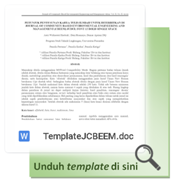The Effect of Plant Characteristics on CO2 Emission Factor Development: A Case Study of Coal-Fired Power Plants in Indonesia
DOI:
https://doi.org/10.23969/jcbeem.v9i1.18935Keywords:
emission factor, CO2, coal-fired power plant, technology types, ageAbstract
The emission factor (EF) describes the relationship between pollutants released into the atmosphere and associated activities. Developing specific EFs is essential for accurate emission calculations in the industrial sector, particularly in coal-fired power plants (CFPPs), a major source of emissions in Indonesia. This study aims to develop specific CO2 EFs for CFPPs in Indonesia by analyzing the influence of power plant characteristics, such as technology type and age, on the EF values. The EFs, expressed in tons of CO2 per unit of energy produced (t TJ-¹), are based on data from 153 units across 66 CFPPs in Indonesia. Five technology types were included in the analysis: ultra-supercritical, super-critical, subcritical-pulverized coal combustion, subcritical-fluidized bed combustion and subcritical–stoker. The study compares the resulting CO2 EFs with the IPCC-2006 default value for sub-bituminous coal and Indonesia’s national EF for medium-quality coal. The average CO2 EF for Indonesian CFPPs was 100.16 t TJ-1, higher than the IPCC-2006 default value (96.1 t TJ-1) but slightly lower than Indonesia’s national EF (100.575 t TJ-¹). A statistical test revealed significant differences between technology and age groups, but post-hoc analysis showed no strong correlation was found between these characteristics and the EF values within specific groups. This indicates that the EF, based on fuel characteristics, is not directly influenced by these plant characteristics. It is hoped that the CO2 EF values obtained from this study will better represent actual conditions, provide a more accurate emission calculations and supporting the development of better emission inventories for cleaner energy generation.
Downloads
References
Budi, R. F. S., & Suparman, S. (2013). Perhitungan faktor emisi CO2 PLTU batubara dan PLTN. Jurnal Pengembangan Energi Nuklir, 15(1), 1-8. https://doi.org/10.17146/jpen.2013.15.1.1612
Caldecott, B., Dericks, G., & Mitchell, J. (2015). Stranded assets and subcritical coal: the risk to companies and investors. Smith School of Enterprise and the Environment.
Cetin, B., & Abacioglu, M. (2013). Economic analysis for rebuilding of an aged pulverized coal-fired boiler with a new boiler in an aged thermal power plant. Advances in Mechanical Engineering, 5, 270159. https://doi.org/10.1155/2013/270159
Damayanti, R., & Khaerunissa, H. (2018). Carbon dioxide EF estimation from Indonesian coal. Indonesian Mining Journal, 21(1), 45-58. https://doi.org/10.30556/imj.Vol21.No1.2018.687
Efendy, R. P., & Dewi, K. (2024). Greenhouse Gasses Inventory on Textile Finishing Industry PT X. Journal of Community Based Environmental Engineering and Management, 8(1), 1–8. https://doi.org/10.23969/jcbeem.v8i1.10442
Eggleston, H. S., Buendia, L., Miwa, K., Ngara, T., & Tanabe, K. (2006). 2006 IPCC guidelines for national greenhouse gas inventories: Volume 1: Energy, Chapter 2: Stationary combustion. Geneva, Switzerland: IPCC.
Erfian, A. (2024). Penentuan faktor emisi karbon dioksida PLTU batubara menggunakan data pengukuran CEMS perbandingannya dengan faktor emisi nasional (Thesis, Institut Teknologi Sepuluh Nopember).
Guttikunda, S. K., & Jawahar, P. (2014). Atmospheric emissions and pollution from the coal-fired thermal power plants in India. Atmospheric Environment, 92, 449-460. https://doi.org/10.1016/j.atmosenv.2014.04.057
Jeon, E. C., Myeong, S., Sa, J. W., Kim, J., & Jeong, J. H. (2010). Greenhouse gas EF development for CFPPs in Korea. Applied Energy, 87(1), 205. https://doi.org/0.1016/j.apenergy.2009.06.015
Kang, S., Cho, S., Roh, J., & Jeon, E. C. (2020). Analysis of main factors for CH4 EF development in manufacturing industries and construction sector. Energies, 13(5), 1220. https://doi.org/10.3390/en13051220
Kementerian Energi dan Sumber Daya Mineral. (2023). Handbook of energy and economic statistics of Indonesia 2022. Jakarta: Kementerian ESDM
Kementerian Energi dan Sumber Daya Mineral. (2019). Pedoman penghitungan dan pelaporan inventarisasi gas rumah kaca bidang energi - sub bidang ketenagalistrikan. Direktorat Jenderal Ketenagalistrikan, Kementerian ESDM.
McBean, E. A., & Rovers, F. A. (1998). Statistical procedures for analysis of environmental monitoring data and risk assessment. Prentice Hall PTR.
Mohamed, O., Khalil, A., & Wang, J. (2020). Modeling and control of supercritical and ultra-supercritical power plants: a review. Energies, 13(11), 2935. https://doi.org/10.3390/en13112935
Nunes, L. J., R. (2023). The Rising Threat of Atmospheric CO2: A Review on the Causes, Impacts, and Mitigation Strategies. Environments, 10(4), 66. https://doi.org/10.3390/environments10040066
Razali, N. M., & Wah, Y. B. (2011). Power comparisons of shapiro-wilk, kolmogorov-smirnov, lilliefors and anderson-darling tests. Journal of statistical modeling and analytics, 2(1), 21-33. https://doi.org/10.12691/wjssh-7-3-3
Ruxton, G., & Beauchamp, G. (2008). Some suggestions about appropriate use of the Kruskal–Wallis test. Animal behaviour, 76(3), 1083-1087. https://doi.org/ 10.1016/j.anbehav.2008.04.011
Sloss, L. L. (2011). Efficiency and emissions monitoring and reporting. Paris: IEA Clean Cloal Centre.
UNFCCC. (2015). UN framework convention on climate change conference of the parties-21: The Paris Agreement (pp. 18–19).
Zhang, D. (2013). Introduction to advanced and ultra-supercritical fossil fuel power plants. In Ultra-supercritical coal power plants (pp. 1-20). Woodhead Publishing.














